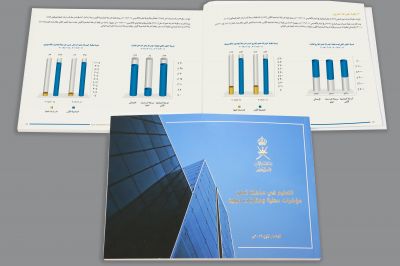
The Secretariat General of the Education Council published a book titled "Education in the Sultanate of Oman: Local indictors and international comparisons". This book is the first of its kind to serve as a guidebook for decision makers, specialists and other concerned people to enable them to get acquainted with aspects of development in the education sector as well as its different issues and problems. This book highlights the most remarkable development features in the educational process in the Sultanate of Oman covering both school education and higher education as from 2010/2011 to 2014/2015 academic years. The book analyzes and investigates statistics and a set of indicators which reflect the realities of the educational process and cover different elements such as students, human resources, efficiency, research and financial expenditure.
Calculation of indicators in this publication relied upon data available on databases of the Ministry of Higher Education, the Ministry of Education and the National Center for Statistics and Information. This data was re-categorized and re-classified to include as much amount as possible of general information in hierarchical time-order according to availability of information.
Educational information is considered among the most important methods in planning educational processes, identifying objectives, setting policies and implementing procedures. Thus, such information is of prime importance to the Education Council since it aims at providing a comprehensive and well-integrated database, which shall contribute to provision of objective reports on the education system as well as to conducting local and international comparisons within the education sector.
The topics of this publication are presented in three sections. The first and the second sections address the most remarkable developments that were achieved in both school education and higher education in terms of numbers of public and private educational institutions (schools, institutes, colleges and universities). The first two sections also state numbers of new students, enrolled students and graduates. They also cover indicators of Omani students movement between institutions inside and outside Oman, indicators of academic and administrative human resources and many other indicators of quality, efficiency and financial expenditure on education. Both first and second sections highlight the quantitative development which the educational sector has witnessed so far.
The third section of the book is designated to compare some educational indicators of the Sultanate of Oman with their counterparts in other countries in accordance with the classification of the UNESCO Institute for Statistics (UIS). Calculation of these indicators relied on the data provided by the Institute as well as on local databases according to the International Standard Classification of Education (ISCED2011).
Through comparing the performance of the Omani Education System with other education systems in the Arab World and in the world from 2010/2011 to 2012/2013 academic years, it is apparent that some indicators reflect the growing development in the educational process at both school and higher education levels. The rate of net enrollment in grade one of the school system was 87% with an annual rate of growth of 2.72% meanwhile the enrollment rate was 79% and 86% in Arab countries and the world with growth rates of -0.02% and 1.95% respectively. The total enrollment rates in pre-school education in the Sultanate of Oman was 52% which is almost close to other rates worldwide. Yet, this rate is double the recorded rate of pre-school enrollment in Arab countries. The rate of net enrollment in the first six grades of school education was 98% in the Sultanate of Oman. The average record was 89% and 91% in the Arab countries and in the world. The rate of net enrollment in higher education institutions was 26% and it was similar to the rates recorded in other Arab countries and the world.
According to latest indicators issued by the National Center for Statistics and Information in 2014/2015 academic year, the Sultanate of Oman has made a remarkable progress in students enrollment rates. Net enrollment in grade one of school education increased to 96.4%. The total enrollment rate increased to 53.6% in pre-school education and to 98.3% in the first six grades of the school system.
On the other hand, the total enrollment rate in higher education institutions for the age group 18 – 22 years increased to 47.5%. This increment is due to the increment of numbers of students admitted to higher education institutions as from 2011/2012 academic year.
It is worth mentioning that many efforts were exerted by the Ministry of Education, the Ministry of Higher Education and the National Center for Statistics and Information as well as other concerned parties to publish this book and produce it in its final version to make specialists and other persons concerned with the education sector get to know the quantitative and qualitative growth that the sector has been recently witnessing.
Concerned and interested readers may visit the Education Council website www.educationcil.gov.om to know more about the contents of this publication.